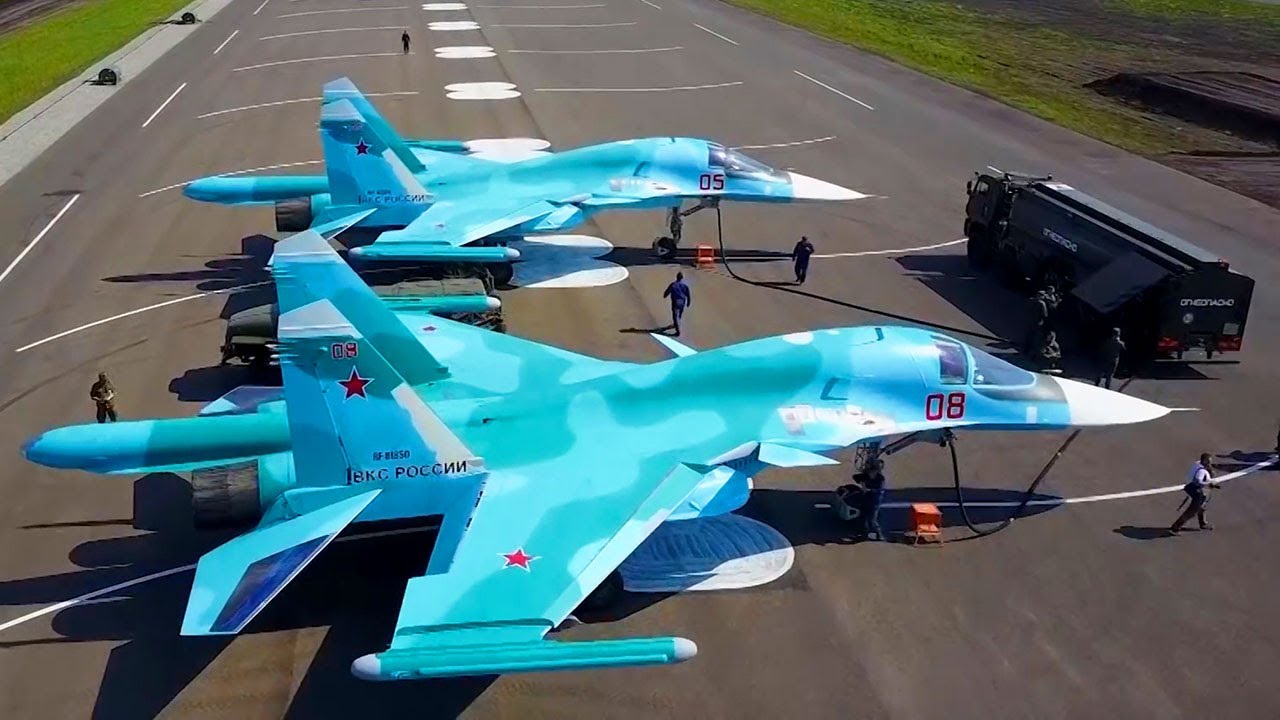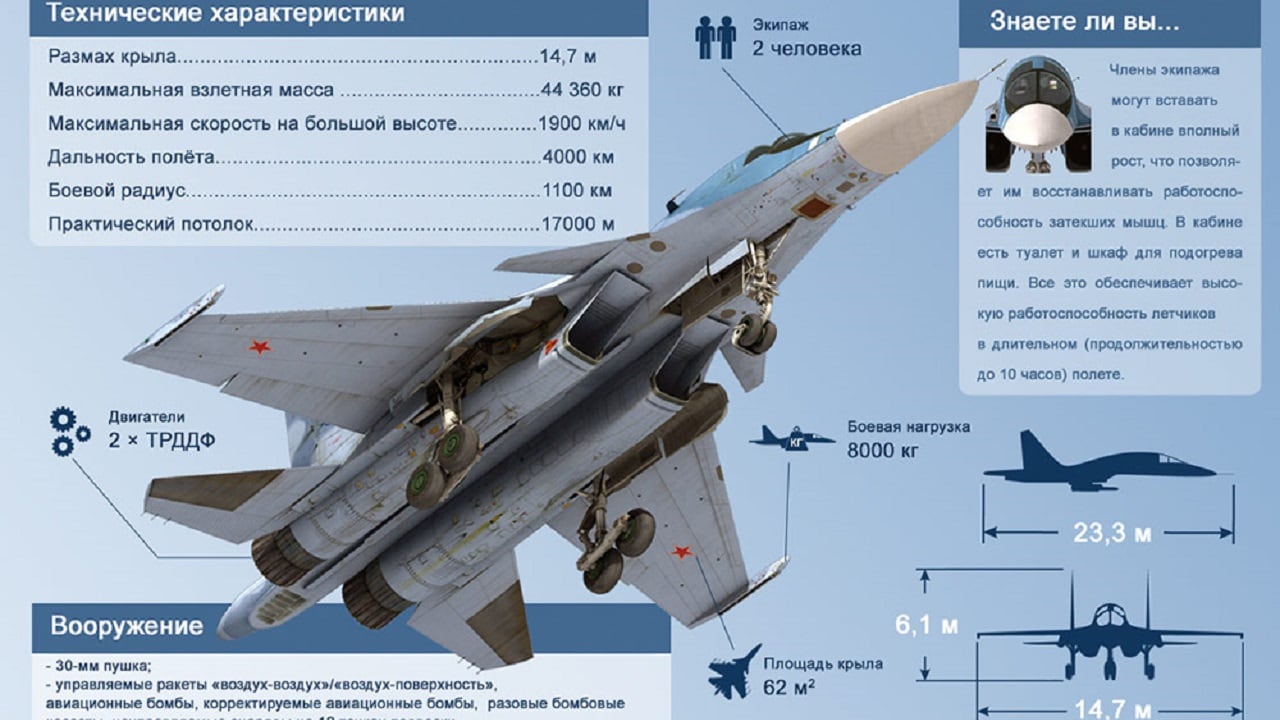The Russian Aerospace Forces have received a fresh batch of Su-34 frontline fighter bombers from the United Aircraft Corporation (UAC, a division of the state tech behemoth Rostec), a statement from the UAC press office on June 1 revealed.
“The UAC has delivered a new batch of Su-34 frontline bombers to the Russian Aerospace Forces. These splendid aircraft have been manufactured at the Chkalov Novosibirsk Aviation Plant. The planes have undergone ground and flight tests and have been delivered to the Defense Ministry of Russia,” the press office said in a statement, as reported by TASS.
The statement further noted that the Su-34 Fullback features extended combat capabilities, enabling it to employ advanced air-launched munitions, expand the conditions and accuracy of bombing runs, and increase the range of striking ground and naval targets.
The last batch of Su-34 fighter bombers was delivered to Russia in November 2022. In a statement issued then, the Russian government informed that the aircraft completed multiple ground and flight tests.
Russia has extensively deployed this aircraft in the ongoing war. The statement announcing the recent delivery emphasized, “Su-34 frontline bombers are a major part of the Russian frontline aviation’s strike power.”
As noted by EurAsian Times, the Su-34 has been used to launch stand-off attacks on Ukraine without entering its saturated airspace.

Moreover, the development comes days after the aircraft displayed spectacular terrain-hugging bombing. Last week, two Russian Su-34 Fullback fighter bombers were caught on camera dropping high-explosive bombs at a very low altitude near the Ukraine border but within mainland Russia.
The video demonstrates how unguided bombs can be difficult to use as they could be seen missing their intended targets. According to speculation, the bombs dropped by the Russian military aircraft were high-explosive freefall bombs from the FAB-500Sh class, which are intended for low-altitude deployment.
Desperate air strike attempts by Russian Su-34 fighter jet on Ukrainian-backed forces who had settled at Grayvoron checkpoint in Belgorod region.
Su-34 flies at ultra-low altitude to drop high-explosive free-falling bombs.
The target was clearly not hit. pic.twitter.com/O4dL4CKgqj
— Clash Report (@clashreport) May 25, 2023
Guy Plopsky, a defense analyst, recently pointed out that the Su-34 aircraft have been employing parachute-retarded bombs to overcome the challenge of conducting strikes from medium and high altitudes due to the persistent threat of Ukrainian GBAD (Ground-Based Air Defense).
By all measures, the Su-34 Fullback fighter bomber is an irreplaceable asset for the Russian Aerospace Forces (VKS), which the aircraft has proven with its performance in the ongoing war against Ukraine. Along with the Su-35, the Su-34 is the most extensively deployed warplane along the frontline.
However, unlike the Su-35 fighter jet, the Su-34 is the odd duck for a simple reason – it is both a fighter jet and a bomber aircraft.
Russia’s Prized Possession: Su-34 Fighter Bomber
Su-34 twin-engine twin-seater deliveries to Russia started in 2014. Based on the Sukhoi Su-27 Flanker air superiority fighter, the aircraft is designed for aerial warfare and bombing missions.
A sophisticated, multi-mode phased array radar with terrain following and avoidance capabilities have been fitted to the Su-34’s nose section.
With a two-seat cockpit and a larger internal fuel tank, the aircraft can take off with a heavy payload. The center tail boom has been modified to accommodate rear-facing radar. The pilot and co-pilot sit in two K-36DM zero/zero ejection seats in the cockpit.
Kris Osborn, President of the Center for Military Modernization, writing about the unique features of the Su-34, says that due to the Su-34’s unusual “fighter-bomber” design and alignment with cutting-edge 4th generation fighter jet modifications, Russia poses distinct and possibly unmatched threats to its adversaries.
The Su-34, despite being a larger aircraft, is similar to 4th-generation Russian airframes like the Su-27 and Su-35, which are a little stealthier. Despite its enormous size, it can operate with cruise missiles and eight tons of precision bombs.
Kris Osborn notes in his writing that the empty weight of the Su-34, in contrast to the Su-27’s 36,000 pounds, is listed at almost 50,000 pounds. The Su-34’s maximum takeoff weight is just under 100,000 pounds, indicating that it can operate with more weapons than other fourth-gen fighters.

In contrast, the maximum takeoff weight of the Su-27 is only 67,000 pounds. To put things into perspective, while the Su-34’s maximum takeoff weight of 99,000 pounds expands its range of missions, it is still less than four times the 414,000-pound maximum takeoff weight of big Russian bombers like the well-known Tupolev Tu-95.
The aircraft is known as a fighter-bomber and yet does not entirely fit into either the fighter jet or the bomber category, going by conventional measures and comparing with the aircraft in the VKS’ arsenal. In fact, at one point, there were speculations that the aircraft would replace the Su-24 as well as the Tu-22.
The Su-34 is a unique aircraft for several reasons. For one, it is a medium or long-range bomber with the high payload and range of a fighter, as well as the duckbill-shaped fuselage (supposedly, the aircraft is known as “Duckling” or “Duckbill” within the Russian military).
This is in part due to the Su-34’s three-surface construction. Two canard lifting surfaces close behind the cockpit contribute to lift and aid in maneuverability in addition to the wings and tail surfaces.
The prominent tail boom on the back of the fuselage is one of the Su-34’s more recognizable features. According to the company website, the boom has a brake parachute, an auxiliary power unit, extra fuel, and a smaller rear-facing radar antenna that can alert pilots to approaching missiles.

Given that its speed is only specified as Mach 1.8, the aircraft would be more vulnerable than its considerably faster, lighter, and more maneuverable competitors like the Su-27. However, it does appear to introduce air combat abilities not generally found in bombers.
The Su-34 could switch from air-to-ground attacks to higher-altitude precision-bombing campaigns, lowering the overall number of airframes required for a given attack mission. This type of dual-role capability undoubtedly expands operational options.
This expands and streamlines the mission area, especially in scenarios where Russia may have an advantage in air dominance and fewer Su-27s are required. A Su-34 could carry out both air combat and ground assault missions in this kind of scenario while introducing glide and precision bombing capabilities to a greater extent.
The B1-B bomber does not operate with fighter-jet-like capabilities, and the B-2 and B-52 are solely bombing platforms, which is interesting because the US does not appear to have an equivalent in certain areas.
US fighter jets of the 4th and 5th generations, including the F-35 and the F-15, can also carry out effective “bombing” missions with precision weapons, albeit to a lesser level.
In Osborn’s words, “This raises the question that Russia’s Su-34 while introducing potentially unparalleled versatility, could be an aircraft “stuck” between missions. Meaning it is too large and heavy to truly be effective as a fighter yet far too small to be sufficiently impactful as a bomber.”
- Contact the author at sakshi.tiwari9555(at)gmail.com
- Follow EurAsian Times on Google News




